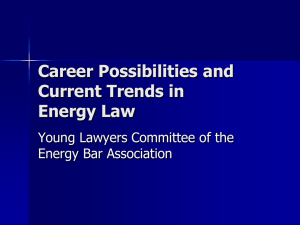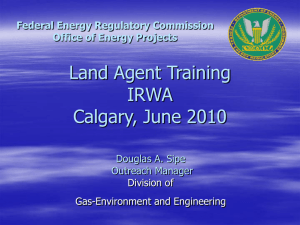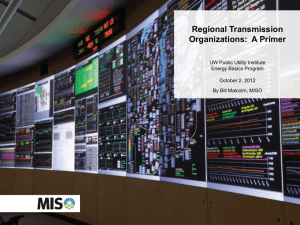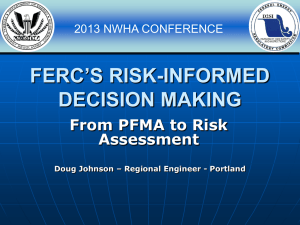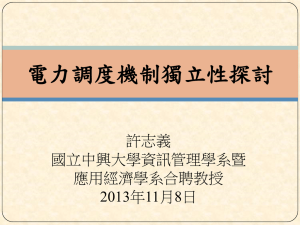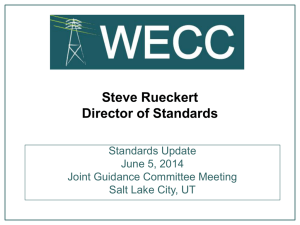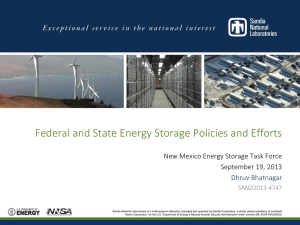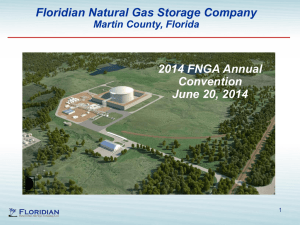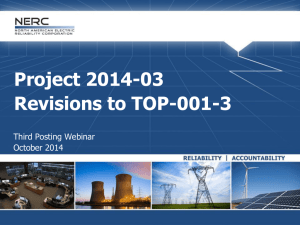Part 1
advertisement
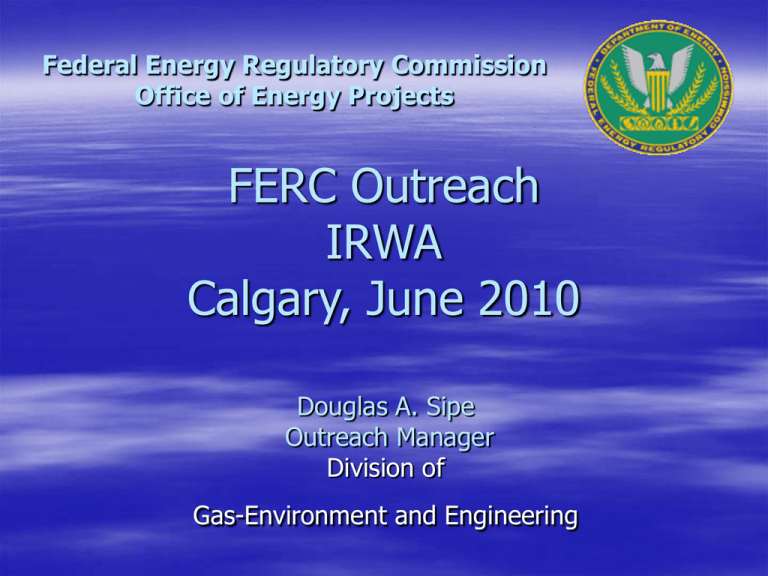
Federal Energy Regulatory Commission Office of Energy Projects FERC Outreach IRWA Calgary, June 2010 Douglas A. Sipe Outreach Manager Division of Gas-Environment and Engineering FERC What is Outreach? An effort to connect ideas or practices to the efforts of other specific audiences A systemic attempt to provide services beyond conventional limits The ability of one community to work beyond its boundaries in unexpected ways to provide for another community Office of Energy Projects FERC Who is FERC? FERC is an independent federal regulatory agency that: Regulates the interstate transmission of natural gas (siting & rates); electricity and oil (rates only); Reviews proposals to build interstate natural gas pipelines and liquefied natural gas (LNG) terminals, and natural gas storage fields Licenses and inspects non-federal hydropower projects Office of Energy Projects FERC FERC Organization Chart Chairman Jon Wellinghoff Energy Projects Administrative Litigation Commissioner Philip D. Moeller External Affairs Administrative Law Judges Commissioner Commissioner Commissioner Marc Spitzer John R. Norris Cheryl LaFleur Enforcement Energy Market Regulation Electric Reliability Executive Director General Counsel Secretary Energy Policy & Innovation Office of Energy Projects FERC FERC’s Siting Authority Section 3 of the Natural Gas Act Determination of consistency with the public interest Section 7 of the Natural Gas Act Determination of public convenience and necessity Energy Policy Act of 2005 Assigns FERC exclusive siting authority—does not preempt other required federal authorizations Mandates use of Pre-Filing Process for LNG terminals Names FERC lead agency for NEPA review and coordinator of all federal authorizations Office of Energy Projects FERC The Pre-Filing Process More interactive NEPA/permitting process, no shortcuts Be more proactive and explore ways to Outreach Earlier, more direct interaction between FERC, other agencies, landowners, and the applicant Transparency in the Pre-Filing Review Process Goal is to resolve problems and have “no surprises” Pre-filing procedures are designed to encourage cooperation with federal, state, and local authorities FERC staff is an advocate for the process, not the project Office of Energy Projects FERC Timelines: Traditional vs. Pre-Filing Process Develop Prepare Study Resource Corridor Reports File At FERC Traditional – Applicant Activities Conduct Scoping (length of study period determined by the Applicant) Review Resource Reports & Analyze Project Traditional – FERC Activities Prepare Resource Reports Develop Study Corridor Approve PF Request (at least 6 mos. before filing) -6 -5 -4 File At FERC Conduct Scoping & Direct Preparation of Resource Reports -3 -2 -1 Issue Final EIS Issue Order Pre-Filing – Applicant Activities Analyze Issue Project Draft EIS 0 Issue Draft EIS 1 2 3 4 Issue Final EIS 5 6 7 8 (months) Issue Order 9 10 Pre-Filing – FERC Activities 11 12 13 14 15 16 17 18 Office of Energy Projects FERC INFRASTRUCTURE BOOM (Certificated in the last 10 years) Pipelines 106 Bcf/day of Capacity and 14,592 Miles Storage Facilities 870 Bcf of Capacity LNG Facilities 37 Bcf/day of Total Capacity Office of Energy Projects FERC Heightened Public Interest Congressional Interest Escalated Significantly Increased calls to FERC’s Office of External Affairs and Office of Enforcement (Dispute Resolution Service) Filed letters and calls to FERC PM’s/Management * Change… landowner calls now being referred to the Dispute Resolution Service Office of Energy Projects The Landowners’ Perspective FERC FERC Outreach Efforts Continue to improve our Outreach Program FERC House calls Address elected officials earlier in the process Continue to consult with and educate federal, state, and local agencies Federal, State, and Local Agency Learning Curve Refine ways to connect with affected stakeholders New Stakeholder Document coming soon FERC's Expectations, Role, and Outreach Goal Office of Energy Projects FERC FERC’s State Outreach Initiative FERC needs to get out in front of projects Industry needs to anticipate infrastructure hotspots and communicate Turn opposition into understanding Communicate to all stakeholders that there is a process in place Office of External Affairs State and Public Affairs Divisions FERC Industry Promotion A Robust Stakeholder & Public Outreach Initiative What is your Communication Plan? What is the Industry Training Protocol? How is the Industry Tailoring their Message? Office of Energy Projects FERC Making Strides Forward INGAA’s Commitment to Landowners Eight Steps to build and maintain strong positive relations with landowners Industry is strengthening overall training Who is the Face of your Company or Project Outreach Coordinators positions are being created *** Good Idea*** Overall Industry Outreach improvement Newsletters and updates of project status Communicating with us (win-win) Office of Energy Projects Communication and Timing - Tiered Approach • Phase 1 – Inform elected officials of potential project and seek feedback – – – – Develop core execution team Develop list and engage Tier One key stakeholders – local, state and federal officials Conduct study route risk assessment/due diligence/feasibility Document Tier One feedback/concerns/suggestions/our responses • Phase 2 - Collaborative effort to engage stakeholders of project’s purpose and need – – – – – Engage Tier Two key stakeholders - Agencies Refine scope with stakeholder feedback Prepare detailed presentation materials Refine study corridor with alternative routes FERC “Pre” Pre-File Meeting • Phase 3 - Advancing the project – – – – – – Refine permitting and regulatory strategy Engage Tier Three key stakeholders – Non-governmental organizations (NGOs) Notify community with voluntary public informational meetings Request survey permission Commence field work Continuous route review 15 FERC Industry Continued Focus Catalog your stakeholders interactions Key when the Commission is looking for answers Amplified Media and Stakeholder Savvy Landowner Complaint Resolution Procedures Protect your Image Communicate your side of the story Don’t sit in Silence Office of Energy Projects FERC Project Timing and the FERC Review Process FERC process is a model that works Pre-filing, application analysis, and post-authorization A process is needed to streamline the siting of energy infrastructure Adequate gas infrastructure is essential The nation has been well-served by the Commission’s siting of natural gas infrastructure Commission analysis and decisions are timely EIS Pre-Filing Environmental Review Process Applicant Process Assesses market need and considers project feasibility FERC Process Requests use of FERC’s Pre-Filing Process Receives Applicant’s request to conduct its review of the project within FERC’s NEPA Pre-Filing Process Studies potential site locations Identifies Stakeholders Holds open house to discuss project Public Input Opportunities Conducts route studies and field surveys. Develops application. Files formal application with the FERC Formally Approves Pre-Filing Process and issues PF Docket No. to Applicant Participates in Applicant’s open house Issues Notice of Intent for Preparation of an EIS opening the scoping period to seek public comments. Holds public scoping meeting(s) and site visits in the project area. Consults with interested stakeholders. Issues Notice of Application Analyzes data and prepares Draft EIS Issues Draft EIS and opens comment period Public Input Opportunities Holds public comment meetings on the Draft EIS in the project area Responds to comments and revises the Draft EIS Issues Final EIS Commission Issues Order Public Input Opportunities Parties can request FERC to rehear decision Submits outstanding information to satisfy conditions of Commission Order Issues Notice to Proceed with construction. FERC Questions? Federal Energy Regulatory Commission 888 First Street, N.E. Washington, DC 20426 Douglas A. Sipe 202.502.8837 douglas.sipe@ferc.gov Office of Energy Projects
